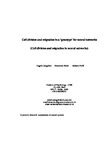Cell division and migration in a `genotype' for neural networks
| dc.contributor.author | Cangelosi, Angelo | |
| dc.contributor.author | Parisi, D | |
| dc.contributor.author | Nolfi, S | |
| dc.date.accessioned | 2015-10-14T14:10:32Z | |
| dc.date.available | 2015-10-14T14:10:32Z | |
| dc.date.issued | 1994-11 | |
| dc.identifier.issn | 0954-898X | |
| dc.identifier.issn | 1361-6536 | |
| dc.identifier.other | 497-515 | |
| dc.identifier.uri | http://hdl.handle.net/10026.1/3632 | |
| dc.description.abstract |
Much research has recently been dedicated to applying genetic algorithms to populations of neural networks. However. While in real organisms the inherited genotype maps in complex ways into the resulting phenotype, in most of this research the development process that creates the individual phenotype is ignored. In this paper we present a model of neural development which includes cell division and cell migration in addition to axonal growth and branching. This reflects, in a very simplified way, what happens in the ontogeny of real organisms. The development process of our artificial organisms shows successive phases of functional differentiation and specialization. In addition, we find that mutations that affect different phases of development have very different evolutionary consequences. A single change in the early stages of cell division and migration can have huge effects on the phenotype, while changes in later stages usually have a less dramatic impact. Sometimes, changes that affect the first developmental stages may be retained, producing sudden changes in evolutionary history. | |
| dc.format.extent | 497-515 | |
| dc.language.iso | en | |
| dc.publisher | Informa UK Limited | |
| dc.title | Cell division and migration in a `genotype' for neural networks | |
| dc.type | journal-article | |
| dc.type | Article | |
| plymouth.author-url | https://www.webofscience.com/api/gateway?GWVersion=2&SrcApp=PARTNER_APP&SrcAuth=LinksAMR&KeyUT=WOS:A1994PV48800005&DestLinkType=FullRecord&DestApp=ALL_WOS&UsrCustomerID=11bb513d99f797142bcfeffcc58ea008 | |
| plymouth.issue | 4 | |
| plymouth.volume | 5 | |
| plymouth.publication-status | Published | |
| plymouth.journal | Network: Computation in Neural Systems | |
| dc.identifier.doi | 10.1088/0954-898X/5/4/005 | |
| plymouth.organisational-group | /Plymouth | |
| plymouth.organisational-group | /Plymouth/Faculty of Science and Engineering | |
| plymouth.organisational-group | /Plymouth/Faculty of Science and Engineering/School of Engineering, Computing and Mathematics | |
| plymouth.organisational-group | /Plymouth/Research Groups | |
| plymouth.organisational-group | /Plymouth/Research Groups/Institute of Health and Community | |
| plymouth.organisational-group | /Plymouth/Research Groups/Marine Institute | |
| dcterms.dateAccepted | 1994-01-01 | |
| dc.identifier.eissn | 1361-6536 | |
| dc.rights.embargoperiod | Not known | |
| rioxxterms.versionofrecord | 10.1088/0954-898X/5/4/005 | |
| rioxxterms.licenseref.uri | http://www.rioxx.net/licenses/all-rights-reserved | |
| rioxxterms.type | Journal Article/Review |


